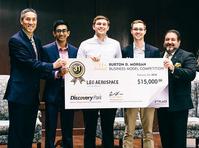IE undergrad co-founds company, develops “rockoons”

Mike Hepfer, an IE undergraduate rising senior, served as President and Program Director of Purdue Orbital for 2017-18, a multidisciplinary, student-run design-build-test team which had up to 115 members this past academic year. From Grandville, Michigan, Hepfer is studying Industrial Engineering and Entrepreneurship. With a background in robot design and fabrication, he served as a Mechanical Design Engineer for Ugo Labs where he designed and fabricated prototype components for a fully automated smoothie machine. He also worked as a Mechanical Engineer for JR Automation.
But his current interest is "rockoons", a combination of a high altitude balloon and a traditional rocket, which he is developing with fellow Purdue Engineering students. Together they founded Purdue University-affiliated startup Leo Aerospace LLC in December 2017. "Leo" stands for Low Earth Orbit. The rockoon idea has been around since the 1950s, but until now no one has developed it into a viable project.
"For me personally, I wanted to found this company to help make profound changes to the space industry," says Hepfer, head of Leo Aerospace product development. "The access to space is severely limited and once that roadblock is removed the potential for new technologies is truly incredible."
Leo Aerospace includes Hepfer; mechanical engineering graduate student Dane Rudy, chief executive officer; and aeronautics and astronautics graduate students Bryce Prior, head of operations and strategy; Drew Sherman, head of vehicle development; and Abishek Murali, head of mission engineering.
Rockoons operate by using a balloon to transport a rocket to the upper atmosphere, where there is 95 percent less atmosphere to cause drag when the rocket is launched from the balloon platform. They are less expensive to deploy than a traditional rocket because the rocket isn't launched until the balloon is 11 miles above Earth. This allows for smaller, cheaper rockets to reach orbit, and works only for microsatellites with a 25 kg payload or less. Leo Aerospace hopes its design will lower the cost and increase the availability of small rocket launches, and revolutionize the space industry by giving priority service to microsatellite developers that now are secondary payloads for large rocket companies.
Watch the Rockoons video (Courtesy of Purdue Mechanical Engineering)
Related Link: http://www.purdue.edu/newsroom/releases/2018/Q2/rockoons-may-soon-make-launching-satellites-into-space-more-accessible.html


